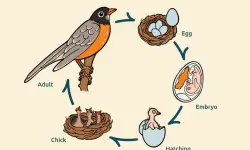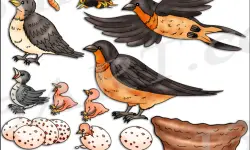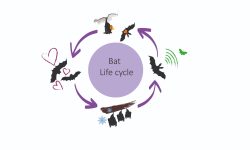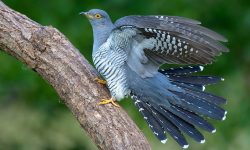Among the rocky shorelines and icy waves of the North Atlantic, the Black Guillemot (Cepphus grylle) lives a life shaped by cold currents, coastal cliffs, and the endless search for fish beneath the sea’s surface. Known for its striking black-and-white plumage and bright red feet, the Black Guillemot is a seabird that thrives in some of the world’s most rugged marine environments. This article explores the natural history, habitat, behavior, and conservation of the Black Guillemot, focusing on its life along the North Atlantic coasts.
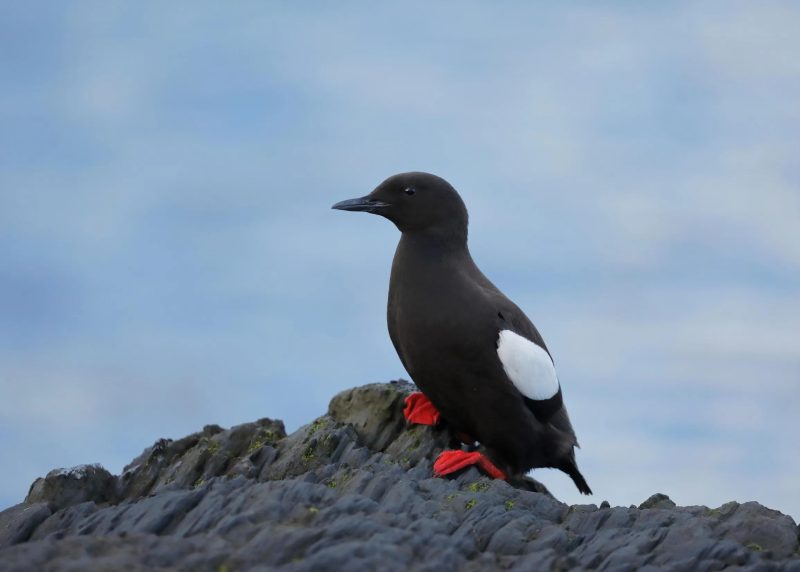
Physical Characteristics of the Black Guillemot
Striking Beauty in Stark Landscapes
The Black Guillemot is a seabird of dramatic contrast—a compact, elegant member of the auk family measuring about 30 to 32 centimeters in length, with a wingspan stretching between 52 and 58 centimeters. Its proportions are perfectly suited for life at sea: stocky yet streamlined, with short wings designed not just for flight, but also for powerful underwater pursuit.
In summer, the bird dons its most eye-catching attire. Its body turns a deep, velvety black, as if dipped in ink, with a bold white wing patch that flashes like a beacon against the dark water and rugged coastal cliffs. But perhaps the most unmistakable feature is its vivid red feet and legs—bright as coral, almost glowing when the bird perches on gray rock or launches from a tide-slick ledge. This splash of crimson color gives the Black Guillemot an unmistakable flair, especially when seen up close or in flight.
Its bill is narrow, fine-tipped, and sharp, built for precision as it captures slippery prey beneath the surface. The eyes are dark and alert, often seeming to scan both sea and sky with equal care.
A Seasonal Shift in Camouflage
As summer fades into the long chill of Arctic and subarctic winter, the Black Guillemot undergoes a dramatic transformation. Its sleek black feathers molt into a dappled palette of soft gray and snowy white, a plumage that blends perfectly with ice floes, frost-covered rocks, and the muted tones of frozen shorelines. This seasonal disguise offers critical camouflage during the harshest time of year, when predators are still active and prey is harder to find.
The transition isn’t just about aesthetics—it’s survival. The white-and-gray winter coat reflects light and cold, helping the bird retain heat in frigid conditions while avoiding unwanted attention from above.
Age and Plumage: Telling the Young from the Adults
Juvenile Black Guillemots bear a close resemblance to winter adults, but with a few subtle differences. Their plumage is often paler, more speckled, and lacks the clean contrast seen in mature birds. Their wing patches are usually smaller, and the overall feathering appears more mottled. This juvenile pattern offers its own form of camouflage during the vulnerable first year of life, when young birds are still learning the demands of survival at sea.
Over time, their feathers darken, their white patches sharpen, and by their second year, they begin to take on the striking appearance of full-fledged adults. Like the landscapes they inhabit, the Black Guillemot changes with the seasons—but always remains perfectly tuned to its northern world.
Habitat and Distribution
North Atlantic Range
The Black Guillemot is a true bird of the North—a sentinel of icy coastlines and wave-lashed cliffs that stretch across the upper reaches of the Atlantic Ocean. From the dramatic fjords of Norway to the glacier-fed inlets of Greenland and Iceland, from the craggy shores of Scotland’s Shetland and Orkney Islands to the cold bays of eastern Canada, this bird thrives where land meets cold, open sea.
Its range arcs across some of the world’s most rugged coasts, including Newfoundland, Labrador, and parts of Alaska and Arctic Russia, hugging the boreal margins of the ocean. Wherever the sea remains ice-free enough to dive and feed through the year, Black Guillemots hold their ground. Unlike many seabirds that wander far between breeding and wintering grounds, this species is largely non-migratory. Most individuals remain faithful to their coastal territory year-round, even when winter closes in with ice and snow. They shift slightly to find open water, but never stray far from the cliffs and shallows that sustain them.
Preferred Habitat
Black Guillemots are specialists of the rock-bound coast, preferring habitats where rugged geology provides both refuge and opportunity. They seek out cliff edges, broken scree slopes, rocky islets, and offshore stacks—places where crevices, cracks, and shadowed hollows offer the perfect shelter for nesting.
In contrast to their more gregarious cousins, these birds often nest alone or in small, scattered groups, taking advantage of natural cavities or even manmade structures like harbor walls, breakwaters, or pier foundations. These choices reflect a blend of caution and independence. Their breeding sites are often hidden from sight, tucked into gaps that provide protection from predators and the harshest elements.
While their home is the rocks, their life is tied to the sea. Black Guillemots are most commonly found near shallow, nearshore waters—zones rich in marine life and ideal for diving. These areas provide abundant prey such as small fish and invertebrates, and their relative calm allows the bird’s compact body and narrow wings to navigate underwater with speed and precision. The bond between rock and sea is absolute: without both, the Black Guillemot cannot thrive.
This delicate dependency—on clean waters, quiet nesting sites, and the unbroken interface between land and ocean—makes the Black Guillemot not only a beautiful seabird, but a living measure of how well our coastal ecosystems endure.
Behavior and Diet
Masters of the Underwater Hunt
The Black Guillemot is not just a bird of the rocks—it is a creature of the sea, equally at home beneath the waves as it is perched on a jagged ledge. Unlike gulls that skim the surface or petrels that ride the wind, this bird dives deep, propelling itself with strong, narrow wings that work like underwater propellers. With each stroke, it slices through the cold North Atlantic, eyes alert and bill poised, in pursuit of prey that flickers just beyond reach.
Its diet is as varied as the ecosystems it inhabits. It hunts small fish, including sand eels, sculpins, blennies, and cod larvae, all staples of the shallow marine shelf. But it is no stranger to crustaceans either—delicately plucking shrimp and amphipods from crevices in the seabed. Marine worms and mollusks are also on the menu, gathered with quick, darting strikes as the bird maneuvers with precision through kelp forests and along submerged rock faces.
These feeding dives are typically brief but intense. The Black Guillemot drops from the surface with barely a splash and may descend as deep as 20 to 30 meters. It rarely stays down for more than half a minute, but in that time, it may seize multiple prey items, often returning to the surface with fish clenched crosswise in its bill—a classic behavior that sets it apart from other auks.
Though often seen alone, it is not unusual to find a foraging pair moving in loose synchrony, diving and resurfacing in quiet rhythm, their red feet paddling softly beneath the waves.
Solitary Spirits of the Cliffs
While many seabirds are highly social, nesting in dense, noisy colonies, the Black Guillemot is more reserved and independent. It claims its own stretch of rocky ledge or crevice, where it breeds in relative solitude or in scattered clusters, rarely forming the vast flocks seen in puffins or razorbills.
During the breeding season, each mated pair becomes fiercely territorial, defending their chosen space with vigor. Males court females with subtle but distinctive displays: synchronized swimming, where both birds glide side by side on calm seas; high-pitched whistles and trills that carry across the wind-swept coastline; and a peculiar sky-pointing posture, where the bird lifts its head skyward and arches its neck in a silent signal of intent.
Their vocalizations are sharp and melodic—clear, rising notes that bounce between cliffs during the golden light of dawn and dusk. These sounds, though modest in volume, are signature songs of northern coastlines, part of the ambient language of the sea.
This mix of underwater mastery and cliffside secrecy defines the Black Guillemot’s unique character. It is a bird that keeps to itself, moves with grace, and feeds with skill—perfectly adapted to a world where wind, rock, and water never sleep.
Breeding and Nesting Habits
Secluded Cradles Among the Rocks
The Black Guillemot does not nest high on sea cliffs or in broad colonies. Instead, it seeks out the cracks and hollows of the shoreline, choosing secrecy over spectacle. From late spring into summer, it returns to familiar coastlines to breed—quiet stretches of rocky islets, wave-worn scree, and harbor walls riddled with dark recesses. There, often just above the tide line, a pair will lay one or two eggs, hidden deep within a crevice or beneath a sheltering stone.
Their nests are simple, often little more than the bare rock or a sparse scattering of pebbles, shells, or driftwood fragments. What the nest lacks in decoration, it makes up for in security. These hidden chambers protect the eggs from wind, weather, and most predators. Within these natural vaults, the Black Guillemot begins its most intimate life cycle.
Both parents share the work of incubation, alternating shifts for nearly a month—28 to 32 days—their movements precise and quiet, their vigilance constant. Unlike more conspicuous seabirds, the Black Guillemot keeps its family life veiled in shadow, tucked behind stone.
Raising the Next Generation
When the chicks hatch, they emerge covered in soft, dark down, their eyes alert but their instincts raw. They are altricial, unable to fend for themselves, and rely completely on their parents for warmth and food. The adults respond with tireless effort, making frequent foraging trips to the sea, returning with small fish held crosswise in their slender bills. This feeding technique, similar to that of puffins, is less showy but no less efficient—each delivery a precise contribution to the chick’s rapid growth.
The nestling period lasts 30 to 40 days, during which time the chick transforms from a downy bundle into a sleek, sea-ready juvenile. The nest becomes a place of silence and patience, disturbed only by the soft flutter of wings or the slap of webbed feet on rock as the parents come and go.
Unlike some seabirds that plunge into the ocean from towering cliffs, the Black Guillemot chick leaves its shelter discreetly—often at night or in dim light, a calculated move that reduces the chance of being seen by predators. Without fanfare or farewell, it slips into the water and swims away, carried into the vastness of the sea by instinct alone.
Its life has barely begun, yet already it knows where to go, how to dive, and when to vanish. The rhythms of the Black Guillemot’s breeding cycle are as precise and deliberate as the tides themselves—unfolding in hidden places, shaped by stone, silence, and salt air.
Adaptations to Harsh Environments
Winter Survival
As winter descends upon the northern coasts and the sea begins to stiffen with ice, the Black Guillemot does not flee to warmer climates like many of its seabird kin. Instead, it stays close—hugging ice-free shorelines, clinging to the margins where land, sea, and cold wind converge. This loyalty to its frigid realm is made possible by an array of finely tuned adaptations.
Its body is compact and muscular, a form built not for soaring but for endurance. Beneath layers of dense, waterproof feathers lies a mantle of soft down that traps warmth against the skin. The bird’s plumage functions like a winter coat, insulating it against freezing air and sub-zero seawater alike. Even as snow falls and waves crash against frozen rocks, the Black Guillemot continues to dive, surfacing with droplets clinging to its dark feathers, unfazed by the bite of winter.
Often, they are seen working the edges of drifting sea ice, where prey still stirs beneath the surface. These ice margins become floating platforms for foraging, vantage points from which the bird can launch into rich waters below. Few birds dare remain so far north through the bleakest months, but the Black Guillemot, shaped by the rhythm of cold seas, endures where others retreat.
Camouflage and Molt
With the changing seasons comes a transformation not just in temperature, but in color. The Black Guillemot sheds its dramatic summer costume—the black velvet body and red feet that once flashed boldly from sea cliffs—and replaces it with a subtler guise. In winter, it wears a plumage of mottled white and ghostly gray, a pattern that mimics snow-dusted rocks and wind-swept shores.
This seasonal molt is more than a cosmetic shift. It is a cloak of survival, blending the bird seamlessly into its icy surroundings. Against a backdrop of snow, frost, and mist, the bird becomes a shadow among shadows, far less visible to predators that patrol land and sky. Even in stillness, it disappears—an act of natural sleight-of-hand perfected over millennia.
Through warmth, camouflage, and quiet resolve, the Black Guillemot persists where the world turns harshest. It is not a bird of retreat, but of resilience—a feathered flame that burns steadily against the chill of the northern dark.
Threats and Conservation
Challenges in a Changing Climate
For all its strength and self-sufficiency, the Black Guillemot remains deeply vulnerable to the forces that now ripple across its northern world. Though not endangered on a global scale, this solitary seabird is finely attuned to a habitat that is shifting beneath its wings and beneath the sea it depends on.
In the Arctic and subarctic zones—regions once ruled by ice, wind, and stability—climate change has begun to unravel old certainties. As sea ice melts earlier each year and ocean temperatures warm, the rhythms that once guided the guillemot’s breeding and foraging are disrupted. Prey species—small fish, crustaceans—migrate to colder waters or decline altogether, forcing the bird to hunt farther, longer, and with less success.
At sea, the dangers are not always visible. Oil spills and marine pollution coat feathers in toxins, stripping away the waterproofing that keeps the guillemot alive in icy waters. A bird slicked in oil cannot dive, cannot insulate, cannot feed. Even small-scale spills near nesting areas can wipe out entire generations.
Overfishing adds further strain, especially in areas where sand eels and other key prey are harvested in unsustainable numbers. The guillemot, unable to switch diets on a whim, suffers the consequences when its hunting grounds are emptied by trawlers.
On land, human disturbance creeps closer to the quiet ledges and rocky crevices where this bird nests in solitude. Increased coastal development, ecotourism, and vessel traffic in sensitive breeding zones can lead to desertion of nests or reduced chick survival. Even well-meaning human presence, if too frequent or poorly timed, can break the careful balance this bird has forged with its environment.
In parts of its range—particularly isolated Arctic islands or northern Scotland—declines in breeding success and population numbers have already been observed. These drops act as warning signs, not just for the bird, but for the broader marine ecosystems they mirror.
Conservation Efforts
Against these mounting pressures, conservationists are working to keep the Black Guillemot’s future afloat. In several regions, coastal reserves and protected nesting areas have been established, offering havens free from human interference during the critical breeding season.
Monitoring programs in the UK, Iceland, Canada, and beyond help track population trends, molting patterns, chick survival, and prey availability, allowing researchers to respond more quickly to emerging threats. Specialized oil spill response teams stand ready in high-risk marine corridors to mitigate the worst impacts when disaster strikes.
Equally important are efforts to promote sustainable fisheries—initiatives that limit the depletion of forage fish, reduce bycatch, and protect feeding grounds that Black Guillemots share with countless other marine animals.
The species is currently listed as Least Concern by the IUCN. But that status belies a delicate reality: many local populations may be only one harsh winter or one bad fishing season away from collapse. In a world growing louder and warmer, the Black Guillemot needs our quiet protection—not just because it is rare, but because it represents a system that still works.
To safeguard this bird is to stand for clean coasts, wild seas, and the deep, unbroken quiet of nature’s edges—the places where wind, wave, and feather still speak a common language.
Why the Black Guillemot Matters
As a year-round resident of the North Atlantic’s harsh coastlines, the Black Guillemot serves as a living indicator of ocean health. It thrives in clean, productive waters and depends on balanced marine ecosystems. Its presence in rocky coves and sea cliffs is a signal that these environments still function. Its beauty lies in its contrast: elegant black feathers above vivid red feet, a solitary hunter among crashing waves, a bird of the cold sea that stays put when others flee. To see a Black Guillemot bobbing near an icy shore is to witness life finely tuned to survive in the world’s most unforgiving places.
Conclusion
The Black Guillemot in the North Atlantic is more than a bird—it is a year-round sentinel of rocky coasts, a skilled diver, and a symbol of resilience. With its solitary habits, seasonal plumage, and underwater agility, it reflects the rhythms and hardships of the ocean world it inhabits. Protecting this species means protecting the coastal habitats, fish stocks, and ocean clarity it depends on. And as climate change reshapes the North Atlantic, keeping watch over the Black Guillemot will help us understand how the sea—and life within it—is changing before our eyes.

